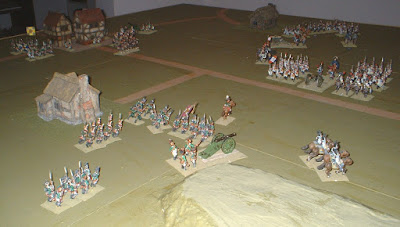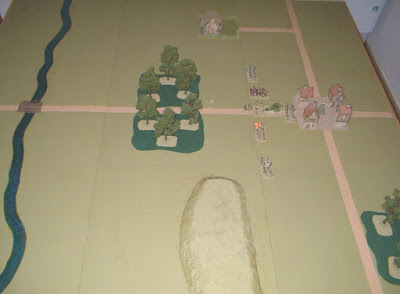General
This campaign is part of the larger 1813 Campaign. It covers the period 17 June to 11 July 1813 and the fighting in central Germany between First French Army and the Russians. It has been done as a separate blog in order to keep all of the relevant reports together and to avoid making the main campaign blog too long and complicated.
We started the campaign on 24 August 2009 and finished on 14 October 2009
Summary of the Campaign
The allied success in northern Germany has left Blucher in a very exposed position. Although he has captured Magdeburg, his left flank is open to an attack by Napoleon’s First French Army. He demands that Kutuzov bring the Russian Army forward from Dresden to Halle to protect his flank.
Kutuzov is less than eager to march forward against Napoleon in person. He has learned during the previous year just how dangerous that could be. However his Army has been allowed to rest for two weeks, while Blucher has borne the brunt of the fighting. His corps have been reinforced and there is no excuse not to move forward to support Blucher.
For two weeks Napoleon has been expecting a Russian advance in support of Blucher.
He has been unable to join the army due to political and administrative problems in Paris. On 10 june he diverts reinforcements from the Imperial Guard to 3rd Corps which is short of a full division of infantry. By 16 June 3rd corps is ready to take the field, and is in reserve at Erfurt. The Imperial Guard will remain at Fulda to await reinforcements.
On 17 June the Russian army start their march from Dresden to the river Saale, and Napoleon departs from Paris to join the Imperial Garde at Fulda. The Halle campaign has started.
On 22 June Kutuzov enters Leipzig and his army take up position to cover the river Saale bridges from Halle to Neustadt. The western bank is only lightly held by the French as they await the arrival of Napoleon with reinforcements.
The first battle of the campaign is at Neustadt on 23 June when the French and Russians both race to take Neustadt. Russians reach it first, but are attacked before they can take possession. In a lengthy fight for the town the French fail to evict the Russians and have to retreat during the night
The following day filled with confidence after their victory at Neustadt, Kutuzov orders an attack on Gera, to deny the French their only bridgehead on west bank of the river Saale. It is a success and the following day the Russians cross to the west bank.
On 25 June Napoleon arrives at the Saale and immediately commits the Imperial Garde to retake Weimar and force the Russians back across the river Saale. In a close fought battle the 4th Russian corps held Weimar right to the end. The garde cavalry were beaten by the Russian cuirassiers, and three of the four garde infantry brigades were shaken. As night fell the sole garde infantry brigade finally pushed the Russians out of Weimar. A relieved Napoleon had halted the Russian advance and regained control of the west bank of the river Saale.
On 28 June Napoleon orders the Westphalians to cross river Saale and attack Lutzen, but there are unable to defeat Russians. After a fierce battle the Westphalians retire to Halle.
Unwilling to admit defeat Napoleon shifts his army south to outflank the Russian line along the east bank of the river Saale. They cross the river and occupy Neustadt, which causes Kutuzov to abandon the Leipzig road and move south to secure the road to Dresden. The result is a battle at Rohenburg on 1 June. Once more the French are beaten and forced to retire to the west bank.
Kutuzov is convinced that the French will now retreat west, and orders his entire army to cross the Saale on the Leipzig road. The French garrison of Halle retreat and the Russians garrison the town. However Napoleon has been reorganizing his army for one final throw of the dice, and on 7 June he attacks Halle.
The final battle of the campaign is a complete victory for the French. The Russian army fall back east and rally around Leipzig. However Napoleon’s army has taken a severe pounding during the campaign, and is in no condition to resume hostilities. He contents himself with holding the river Saale bridges, and both armies settle down to await resupply and reinforcements.
The campaign has been a limited success for the French. They have held the Russians on the line of the river Saale. They have also extended the line of the Second Army to the north on the river Elbe. But in doing so they have suffered heavy casualties and are in need of a considerable rest before Napoleon can hope to continue the struggle.
The Russian army is also in line with the Prussians to the north. The great advance has been brought to a complete standstill. But they have both achieved a number of victories against the French, and require only a good rest, reorganization and resupply to be ready to resist any further French advance.








































